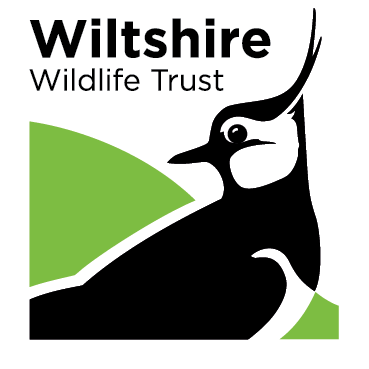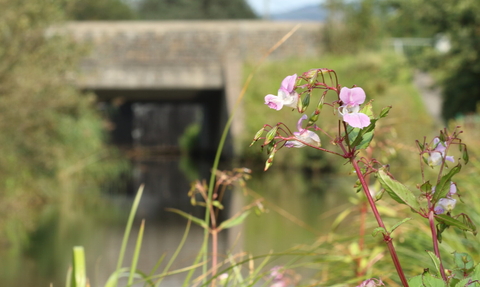
Vaughn Matthews
Invasive Non Native Species
What are invasive non-native species?
Invasive Non-Native Species (INNS) arrived in Great Britain due to accidental human transportation, or through natural dispersal from non-native populations in Europe. More than 2000 species of plants and animals from around the globe have found their way here.
While the majority are harmless, approximately 10-15% of them spread and turn into invasives. This percentage can have a negative impact on our native species by competing for resources, or by parasitism, disease or direct consumption. These invasives can impose economic burdens and can influence our health and way of life.
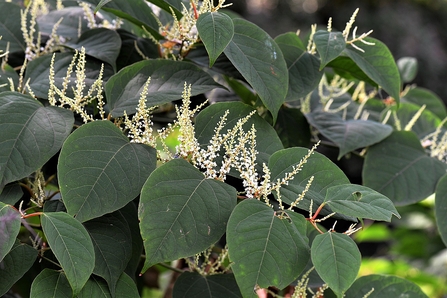
Erwin, Pixabay
What can I do to help?
Recording invasive non-native Species
In Britain we are fortunate to have a collection of information about our flora and fauna, gathered by passionate recorders over the past 200 years. Every record of non-native species is valuable, as it helps identify the trends of the species growth and their location, for future treatment, if necessary. With the advancement of smartphone apps and online recording platforms, it is now more accessible for individuals (Citizen Science) to contribute valuable biological data regarding non-native species.
Where to send your records
If you have a sighting of a certain species, we encourage you to use either iRecord or INNS Mapper which have both smartphone apps and websites. If possible, try and send a photo of the species to help identify them. Please note the yellow legged (Asian) hornet can only be recorded on iRecord due to it being an alert species.
Report your INNS sighting on INNS Mapper
Get involved
Everyone can help prevent the spread of invasive non-native species by following these five simple steps:
- Record your sightings, particularly alert species.
- Never release your pets into the wild – It can be cruel and harm wildlife.
- Be Plant Wise. Help native wildlife to thrive by stopping the spread of Invasive non-native plants. Pond and aquarium plants can devastate a natural waterbody due to the speed at which they spread.
- Check Clean Dry. Help stop the spread of invasive plants and animals in our native waters. Keep clothing, footwear and equipment used in water free from invasive non-native species after use.
- Local Action Groups (LAGS). Volunteer with us at the Wiltshire Wildlife Trust and other LAGS to tackle invasive species management. LAGS include community action volunteer groups; Wildlife Trusts & River Trusts.
Awareness
- Ask fishing friends if they are aware of the Check Clean Dry method to show how easy it is to keep kit, invasive free.
- If you have a green fingered gardening friend/relative, share with them the Be Plant Wise material and information.
- Educate children. Try to involve children in identifying and acknowledging what the INNS are, and how they can affect us and the wildlife around us. They are the future.
- Share information with colleagues at work, friends etc. The more people aware, the more action can be taken to prevent the spread of INNS.
- Get trained up. See below for free training courses. Protect the countryside.
- Volunteer with us and gain on-site knowledge. Himalayan Balsam pulling sessions are held throughout the summer months.
Training
Training is important to help identify the species involved, create an action on bio security, and putting techniques into good practice. The NNSS, GB Non-Native Species Secretariat have developed a series of free e-learning modules funded by DEFRA. These are available for anyone working in the field or with an interest in this area. Please check out the online training section here. Volunteering with us at the WWT to tackle Himalayan Balsam and Orange Balsam through the summer, can give you the confidence to recognise these plants in the wild.
Strategy
By following the refreshed NNSS Strategy (2023 – 2030), working together will help build on the successes of previous years and sets out a series of ambitious aims to guide strong partnership of government, voluntary organisations, NGOs, researchers, businesses and the public into 2030.
Invasive Species List
Here are a list of some of the Invasive Non Native Species found in Wiltshire and the work that Wiltshire Wildlife Trust does to help control the spread of them.
Himalayan Balsam
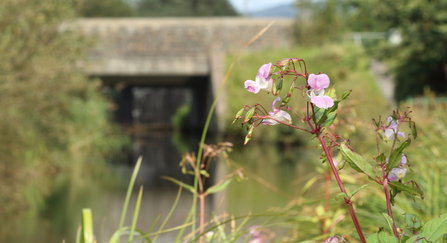
Vaughn Matthews
Despite its attractive pink or white flower, that bees love, Himalayan Balsam (Impatiens glandulifera) is a very quick growing, annual flowering plant that out competes the native flora. The seed pods are like coiled springs ready to disperse the seed up to seven metres away. Each plant is capable of producing 800 seeds, so coverage is vast if left without management. It can manage to grow with very little light and can grow anywhere. Once the plant has had a season, the stem dries out and as it has a very shallow rooting system, it can be pulled out of the riverbanks by the first floods. This leaves the banks bare and causes erosion.
The easiest way to control balsam is by pulling the plant before it starts going to seed. Continued pulling can eradicate the plant within a few years. This can be a daunting task and is best done in a group, with friends or volunteering.
The Wiltshire Wildlife Trust has been tackling Balsam for years and in some areas have completely eradicated it. This wouldn’t have been possible without the help of our core volunteers. Join the Water Teams opportunity here to volunteer with us this coming summer.
Funding to run these sessions have been from the Bristol Avon catchment partnership and DEFRA through the Environment Agency.
Giant Hogweed
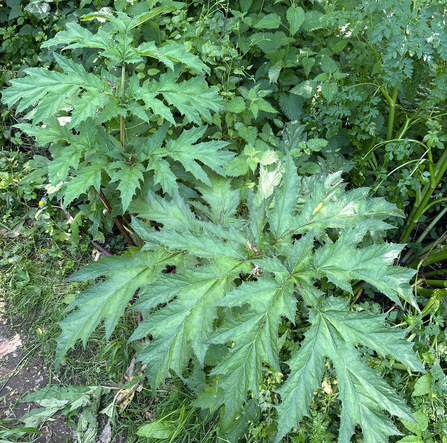
Giant hogweed (Heracleum mantegazzianum) belongs to the same family of Apiaceae, like the Carrot, Parsnip and Coriander.
First introduced into the UK as an ornamental in the 19th century, where it escaped and quickly naturalised. Its origins are from Central Asia and the Caucasus mountains. It is often found on riverbanks where the seeds travel down the water course. It thrives in derelict gardens and neglected waste ground.
Giant hogweed is similar to Common hogweed and flowers like cow parsley, and once fully grown can reach heights between 1.5m – 5m tall. The leaves can reach 1.5m – 3m long and look like rhubarb leaves. The underside of the leaf can be hairy, and the leaf can have sharp or jagged edges. The stems are green with purple blotches and bristles. The flowers are often around 60cm in diameter. Everything about this plant is giant.
Please take care around this plant and avoid any contact with it. The sap of this plant contains furocourmarin, which makes skin extremely sensitive to sunlight. If exposed to sunlight, the skin can blister badly. This can continue to affect the skin for months afterwards. It is best to wash your skin as soon as possible after contact and seek medical advice.
Dealing with this plant can be difficult and we have to recommend using herbicides, through a specialist contractor with stem injection. If this plant is spotted out in the countryside, please use the INNS Mapper website or App to report the sighting.
The WWT has funding to tackle these invasives on the riverbanks of the Hampshire Avon and run regular surveys for them.
Japanese Knotweed
©Philip Precey
Japanese Knotweed (Fallopia japonica) is a perennial that stands about two metres tall. The rhizomes push the stem up through the earth and grow spear shaped leaves. The flower has a small whitish orchid look, which doesn’t go to seed in the UK. Instead, the plant can grow fresh sprouts from less than a one-inch cutting. Thus, can spread downstream extremely quickly if mis-managed. This is one of the most economically important invasive non-native species, as eradication is required by law.
Dealing with this plant can be difficult and we have to recommend using herbicides, through a specialist contractor with stem injection. If this plant is spotted out in the countryside, please use INNS Mapper to report the sighting.
The WWT has funding to tackle these invasives on the riverbanks of the Bristol Avon from the Bristol Avon Catchment Partnership and the Hampshire Avon from DEFRA through the Environment Agency. and run regular surveys for them.
Mink
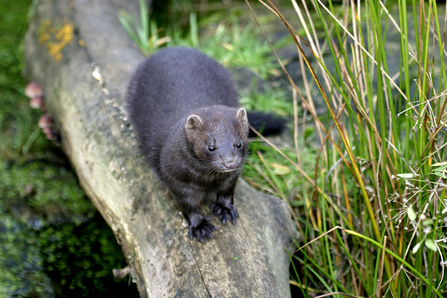
©Wildstock
Invasive non-native American Mink (Neovison vison) breed across most of the country. It’s an active predator, feeding on anything that's big enough to catch, including ground-nesting birds and native water voles, which are now under threat of extinction. Mink are good swimmers and females are small enough to enter the water-line burrows of water voles and take their young.
The mink is a small, lithe mammal, with brown-black fur, a narrow snout, a small white chin, and a white throat. Mink can be distinguished from otters by their smaller size, darker fur, and a smaller face.
Wiltshire Wildlife Trust are funded by Defra through the Environment Agency to run a mink removal project on the Hampshire Avon and its catchments.
The Waterlife Recovery Trust are doing great work to eradicate mink in Norfolk and Suffolk and are starting to push west wards across the country. See their work here.
Yellow Legged (Asian) Hornet
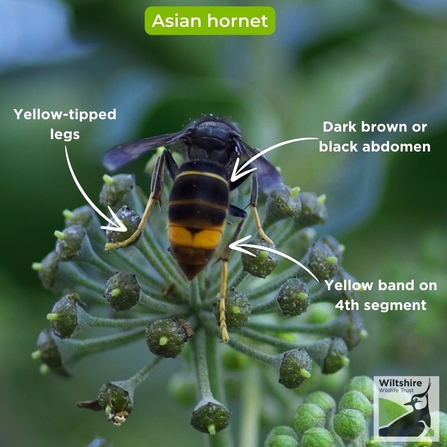
One species of high concern is the Asian hornet, which is threatening our native insects. The Asian hornet is one of 19 invasive species which are currently on alert due to the damage they can do to native wildlife. They are a predator to the majority of our pollinators, including honeybees, with one of their nests consuming 11kg of insects in one year. They have no natural predator in the UK, so their numbers can easily increase if not controlled, presenting a huge risk to Wiltshire’s insect population. They also present a health risk to those who have allergies to hornet or wasp stings.
The Asian hornet first arrived in France in 2005, after being transported inside a container of pottery from China and has altered the biodiversity there as a result. It spread rapidly throughout the 12 neighbouring European countries including the UK, where a number of sightings have been recorded since 2016. In 2023, there were 72 nests found in 56 locations across the UK, which is more than the past 6 years combined. This year, sightings have already been recorded in Kent. This is a pivotal moment – we need eyes on the ground everywhere across Wiltshire to spot Asian hornets. Please be extra vigilant!
